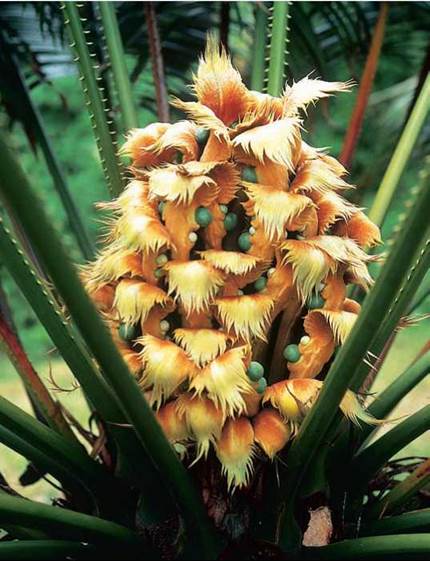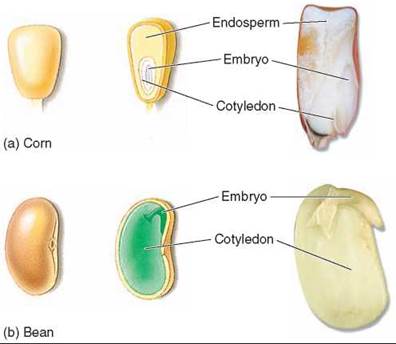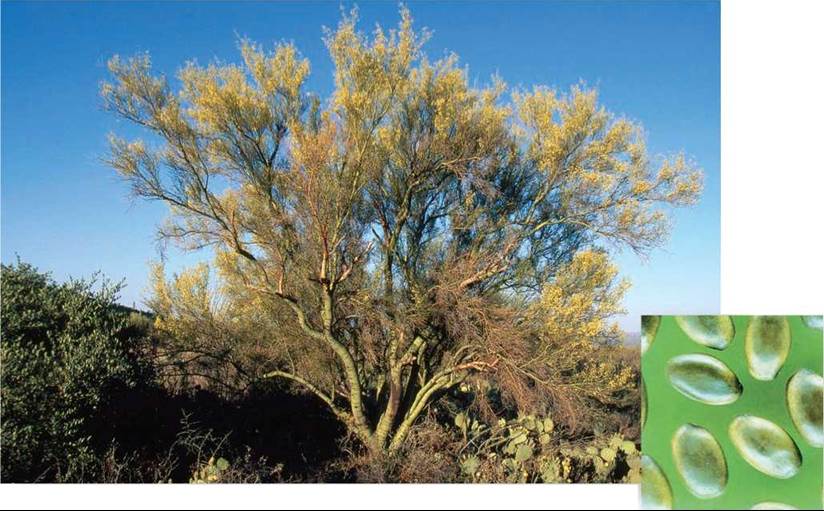THE LIVING WORLD
Unit Seven. Plant Life
32. Evolution of Plants
32.6. Evolution of Seed Plants
A key evolutionary advance among the vascular plants was the development of a protective cover for the embryo called a seed. The seed is a crucial adaptation to life on land because it protects the embryonic plant when it is at its most vulnerable stage. The plant in figure 32.10 is a cycad and its seeds (the green balls in the photo) develop on the edges of the scales of the cone. The embryonic plants are inside the seeds where they are protected. The evolution of the seed was a critical step in allowing plants to dominate life on land.

Figure 32.10. A seed plant.
The seeds of this cycad, like all seeds, consist of a plant embryo and a protective covering. A cycad is a gymnosperm (naked-seeded plant), and its seeds develop out in the open on the edges of the cone scales.
The dominance of the sporophyte (diploid) generation in the life cycle of vascular plants reaches its full force with the advent of the seed plants. Seed plants produce two kinds of gametophytes—male and female, each of which consists of just a few cells. Both kinds of gametophytes develop separately within the sporophyte and are completely dependent on it for their nutrition. Male gametophytes, commonly referred to as pollen grains, arise from microspores. The pollen grains become mature when sperm are produced. The sperm are carried to the egg in the female gametophyte without the need for free water in the environment. A female gametophyte contains the egg and develops from a megaspore produced within an ovule. The transfer of pollen to an ovule by insects, wind, or other agents is referred to as pollination. The pollen grain then cracks open and sprouts, or germinates, and the pollen tube, containing the sperm cells, grows out, transporting the sperm directly to the egg. Thus free water is not required in the pollination and fertilization process.
Botanists generally agree that all seed plants are derived from a single common ancestor. There are five living phyla. In four of them, collectively called the gymnosperms (Greek, gymnos, naked, and sperma, seed), the ovules are not completely enclosed by sporophyte tissue at the time of pollination. Gymnosperms were the first seed plants. From gymnosperms evolved the fifth group of seed plants, called angiosperms (Greek, angion, vessel, and sperma, seed), phylum Anthophyta. Angiosperms, or flowering plants, are the most recently evolved of all the plant phyla. Angiosperms differ from all gymnosperms in that their ovules are completely enclosed by a vessel of sporophyte tissue in the flower called the carpel at the time of pollination. We will discuss gymnosperms and angiosperms later in this chapter.
The Structure of a Seed
A seed has three parts that are visible in the corn and bean seeds shown in figure 32.11: (1) a sporophyte plant embryo, (2) a source of food for the developing embryo called endosperm in flowering plants (the endosperm makes up most of the seed in corn and is the white part of popcorn), and (3) a drought-resistant protective cover. In some seeds, the endosperm is used up during the development of the embryo and is stored as food by the embryo in thick “leaflike” structures called cotyledons. The endosperm is replaced by the cotyledon, as in the bean seed. Seeds are one way in which plants, anchored by their roots to one place in the ground, are able to disperse their progeny to new locations. The hard cover of the seed (formed from the tissue of the parent plant) protects the seed while it travels to a new location. The seed travels by many means such as by air, water, and animals. Many airborne seeds have devices to aid in carrying them farther. Most species of pine, for example, have seeds with thin flat wings attached. These wings help catch air currents, which carry the seeds to new areas. Seed dispersal will be discussed further later in this chapter and in chapter 34.

Figure 32.11. Basic structure of seeds.
A seed contains a sporophyte (diploid) embryo and a source of food, either endosperm (a) or food stored in the cotyledons (b). A seed coat, formed of sporophytic tissue from the parent, surrounds the seed and protects the embryo.
Once a seed has fallen to the ground, it may lie there dormant for many years. When conditions are favorable, however, and particularly when moisture is present, the seed germinates and begins to grow into a young plant (figure 32.12). Most seeds have abundant food stored in them to provide a ready source of energy for the new plant as it starts its growth.

Figure 32.12 Seeds allow plants to bypass the dry season
Seeds remain dormant until conditions are favorable for growth. When it does rain, seeds can germinate, and plants can grow rapidly to take advantage of the relatively short periods when water is available. This palo verde desert tree (Cercidium floridum) has tough seeds (inset) that germinate only after they are cracked. Rains leach out the chemicals in the seed coats that inhibit germination, and the hard coats of the seeds may be cracked when they are washed down gullies in temporary floods.
The advent of seeds had an enormous influence on the evolution of plants. Seeds are particularly adapted to life on land in at least four respects:
1. Dispersal. Most importantly, seeds facilitate the migration and dispersal of plant offspring into new habitats.
2. Dormancy. Seeds permit plants to postpone development when conditions are unfavorable, as during a drought, and to remain dormant until conditions improve.
3. Germination. By making the reinitiation of development dependent upon environmental factors such as temperature, seeds permit the course of embryonic development to be synchronized with critical aspects of the plant’s habitat, such as the season of the year.
4. Nourishment. The seed offers the young plant nourishment during the critical period just after germination, when the seedling must establish itself.
Key Learning Outcome 32.6. A seed is a dormant diploid embryo encased with food reserves in a hard protective coat. Seeds play critical roles in improving a plant's chances of successfully reproducing in a varied environment.